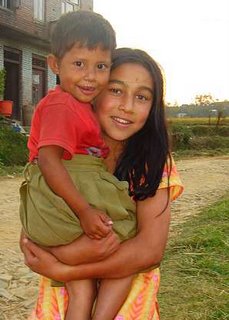
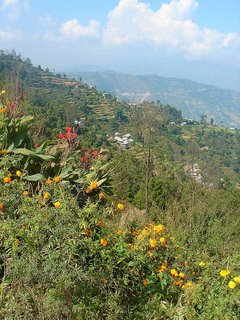 Talk About the Weather
Talk About the Weather While southern India has been flooding, leading to deaths, a train derailing and a relief riot (a riot? in Tamil Nadu? and those Tamils being such mild-mannered folk, imagine that), the weather here is wonderful. Evidently the second monsoon doesn't make it to Nepal. Rainy season is June or July-September, that's it. During those months the rain makes trekking impossible. Even if you don't mind a shower, the leeches are a serious problem in the forests. By end of September and 1st week in Oct, the rain has stopped, skies are clear, weather fair and mountain visibility at its peak (ha ha, bad pun).
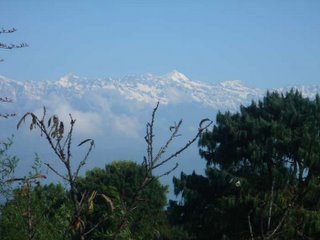 High season for Tibetan visiting (Kathmandu is the gateway toTibet, unless you want to go through Chengdu in China, and why give the Chinese any more of your money than you have to?) is July-October, since later it gets a bit cold there. It is not hard to get into Tibet anymore, just a bit expensive. Now there is a bus, a 2-day ride on a luxury coach from Kathmandu to Lhasa, for the first time. Formerly you had to fly from Kathmandu to Lhasa for $300 one way! For that money, you can fly to Europe. It still requires a Chinese visa, and that you be part of a group, not a solo traveler, but this is not hard to arrange - there are always people around Kathmandu on their way to Lhasa.
High season for Tibetan visiting (Kathmandu is the gateway toTibet, unless you want to go through Chengdu in China, and why give the Chinese any more of your money than you have to?) is July-October, since later it gets a bit cold there. It is not hard to get into Tibet anymore, just a bit expensive. Now there is a bus, a 2-day ride on a luxury coach from Kathmandu to Lhasa, for the first time. Formerly you had to fly from Kathmandu to Lhasa for $300 one way! For that money, you can fly to Europe. It still requires a Chinese visa, and that you be part of a group, not a solo traveler, but this is not hard to arrange - there are always people around Kathmandu on their way to Lhasa.
 "Trekking" is actually a Boer (Dutch South African) word, and what has become the trekking industry developed some time in the 1960s after a British mountaineer, Capt. Robbie Somebody-whose-last-name-escapes-me, unwisely ignored local lore and broke his leg trying to climb the forbidden Machapuchare (which still has yet to be scaled; now climbing it is forbidden by law). He then began organizing walking expeditions at lower elevations. At that time, there was no accomodation for visitors in these areas which had rarely seen a foreign face ("foreign" being someone from beyond the next village), so trekkers had to arrange to stay in homes of locals, or to camp out. Nowadays there are all manner of lodges and "tea houses" along the well-traveled standard trekking routes.
"Trekking" is actually a Boer (Dutch South African) word, and what has become the trekking industry developed some time in the 1960s after a British mountaineer, Capt. Robbie Somebody-whose-last-name-escapes-me, unwisely ignored local lore and broke his leg trying to climb the forbidden Machapuchare (which still has yet to be scaled; now climbing it is forbidden by law). He then began organizing walking expeditions at lower elevations. At that time, there was no accomodation for visitors in these areas which had rarely seen a foreign face ("foreign" being someone from beyond the next village), so trekkers had to arrange to stay in homes of locals, or to camp out. Nowadays there are all manner of lodges and "tea houses" along the well-traveled standard trekking routes.
Nepal's best season for trekking is October-March, since the monsoon clouds have passed and visibility is at its best. The best time for higher elevations (Everest Base Camp and so on) is October-November; later these places have snow and are only for masochists and people who like to tell macho stories about avalanches and frostbite - or those who can afford a fortune in North Face down gear and professional porters.
After November, there is still lots of great trekking at hilly lower  elevations with views of the icy mountains in the distance, and there's always the centrally-located lakeside town Pokhara, a sort of dirtier Switzerland where it's always 10 degrees warmer than the rest of the country, yet you get stunning views of the Annapurna range. In the Kathmandu Valley, it never snows, but there is morning frost on the ground from late
elevations with views of the icy mountains in the distance, and there's always the centrally-located lakeside town Pokhara, a sort of dirtier Switzerland where it's always 10 degrees warmer than the rest of the country, yet you get stunning views of the Annapurna range. In the Kathmandu Valley, it never snows, but there is morning frost on the ground from late
November through January.
By March, it's getting warm at lower elevations, but the flowers are all in bloom, including the famous rhododendrons (the national flower) and it's still cool up higher; April-May are too hot at lower elevations, plus the approaching monsoon makes visibility poor everywhere.
Staying Put
Unfortunately, staying here long-term is a legal challenge. Somewhat like Sri Lanka, and unlike 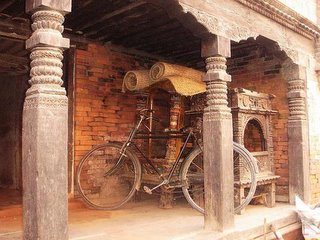 India, Nepal has made their visitor's visas quite limited. A foreign national can only stay in Nepal five (5) months out of any calendar year. That means, since I arrived July 18, I can extend my visa only through mid-December. (Actually, I didn't know this, but managed to arrive at the perfect time to spend 5 months here.) Between December 12 and January 1st, I must exit the country. After January 1st, I am allowed to re-enter for any period of five months (that is, January-May, or July-Dec., or any combination totalling not more than five months). The only ways around this: a student visa (must be enrolled a certain # of hours at a recognized university) which allows about 8 months, or a business visa, which allows 1 year.
India, Nepal has made their visitor's visas quite limited. A foreign national can only stay in Nepal five (5) months out of any calendar year. That means, since I arrived July 18, I can extend my visa only through mid-December. (Actually, I didn't know this, but managed to arrive at the perfect time to spend 5 months here.) Between December 12 and January 1st, I must exit the country. After January 1st, I am allowed to re-enter for any period of five months (that is, January-May, or July-Dec., or any combination totalling not more than five months). The only ways around this: a student visa (must be enrolled a certain # of hours at a recognized university) which allows about 8 months, or a business visa, which allows 1 year.
In the good old days of the 1960s and 70s, there actually were no Nepali visas. People came from India to spend the (then required) six months between Indian visas, 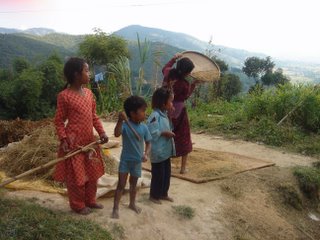 and in the hippy days, they stayed...and stayed....and stayed. They often ran out of money and got involved in the drug trade or other activities that didn't contribute to international relations. Relatively conservative Nepali society frowned on scantily-clad layabouts (unless they were forking over lots of tourist money) and tightened the visa restrictions. A few years ago, you had to prove that you were solvent before entering the country. They required proof that you had at least $5.00 US minimum per each day of your intended stay. This regulation has been relaxed, as has the 2% "tourist tax" on everything you do. (Now they hit you for departure tax at the airport, but strangely, not if you arrive by bus, which I did.)
and in the hippy days, they stayed...and stayed....and stayed. They often ran out of money and got involved in the drug trade or other activities that didn't contribute to international relations. Relatively conservative Nepali society frowned on scantily-clad layabouts (unless they were forking over lots of tourist money) and tightened the visa restrictions. A few years ago, you had to prove that you were solvent before entering the country. They required proof that you had at least $5.00 US minimum per each day of your intended stay. This regulation has been relaxed, as has the 2% "tourist tax" on everything you do. (Now they hit you for departure tax at the airport, but strangely, not if you arrive by bus, which I did.)
Contrast this with India, where they really don't give a darn how many times you enter and re-enter as a tourist. The visa fees are cheaper there, too. Five months in Nepal (the first 2 months are $30, each following month is $30) will cost you $120 US. Six months in India is only $65!
Another interesting tidbit: the $30 initial visa fee is payable upon arrival at the border or airport - no need to arrange one in advance, very handy - but it must be paid in US dollars. Even for non-US citizens! My Canadian and UK friends had to get US dollars to pay the fee. Why dollars, especially now that the Euro is stronger? and where does this go? right into the King's pocket, I reckon. But you didn't hear me say that - it's a crime to criticize His Majesty, Kantipur FM station just got shut down (the police raided them at midnight, seizing all their equipment) for committing this blasphemy a couple weeks ago.

 Talk About the Weather
Talk About the Weather  High season for Tibetan visiting (
High season for Tibetan visiting ( "Trekking" is actually a Boer (Dutch South African) word, and what has become the trekking industry developed some time in the 1960s after a British mountaineer, Capt. Robbie Somebody-whose-last-name-escapes-me, unwisely ignored local lore and broke his leg trying to climb the forbidden Machapuchare (which still has yet to be scaled; now climbing it is forbidden by law). He then began organizing walking expeditions at lower elevations. At that time, there was no accomodation for visitors in these areas which had rarely seen a foreign face ("foreign" being someone from beyond the next village), so trekkers had to arrange to stay in homes of locals, or to camp out. Nowadays there are all manner of lodges and "tea houses" along the well-traveled standard trekking routes.
"Trekking" is actually a Boer (Dutch South African) word, and what has become the trekking industry developed some time in the 1960s after a British mountaineer, Capt. Robbie Somebody-whose-last-name-escapes-me, unwisely ignored local lore and broke his leg trying to climb the forbidden Machapuchare (which still has yet to be scaled; now climbing it is forbidden by law). He then began organizing walking expeditions at lower elevations. At that time, there was no accomodation for visitors in these areas which had rarely seen a foreign face ("foreign" being someone from beyond the next village), so trekkers had to arrange to stay in homes of locals, or to camp out. Nowadays there are all manner of lodges and "tea houses" along the well-traveled standard trekking routes. elevations with views of the icy mountains in the distance, and there's always the centrally-located lakeside town Pokhara, a sort of dirtier
elevations with views of the icy mountains in the distance, and there's always the centrally-located lakeside town Pokhara, a sort of dirtier 
 and in the hippy days, they stayed...and stayed....and stayed. They often ran out of money and got involved in the drug trade or other activities that didn't contribute to international relations. Relatively conservative Nepali society frowned on scantily-clad layabouts (unless they were forking over lots of tourist money) and tightened the visa restrictions. A few years ago, you had to prove that you were solvent before entering the country. They required proof that you had at least $5.00 US minimum per each day of your intended stay. This regulation has been relaxed, as has the 2% "tourist tax" on everything you do. (Now they hit you for departure tax at the airport, but strangely, not if you arrive by bus, which I did.)
and in the hippy days, they stayed...and stayed....and stayed. They often ran out of money and got involved in the drug trade or other activities that didn't contribute to international relations. Relatively conservative Nepali society frowned on scantily-clad layabouts (unless they were forking over lots of tourist money) and tightened the visa restrictions. A few years ago, you had to prove that you were solvent before entering the country. They required proof that you had at least $5.00 US minimum per each day of your intended stay. This regulation has been relaxed, as has the 2% "tourist tax" on everything you do. (Now they hit you for departure tax at the airport, but strangely, not if you arrive by bus, which I did.)













No comments:
Post a Comment